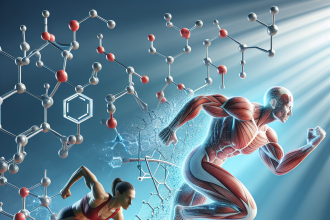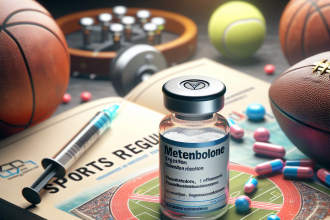-
Table of Contents
Nandrolone: Optimizing Dosage for Athletic Results
Nandrolone, also known as 19-nortestosterone, is a synthetic anabolic-androgenic steroid (AAS) that has been used in the field of sports pharmacology for decades. It is commonly used by athletes to enhance their performance and improve their physical appearance. However, like any other AAS, nandrolone must be used with caution and proper knowledge to avoid potential side effects and maximize its benefits. In this article, we will discuss the optimal dosage of nandrolone for athletic results, backed by scientific evidence and expert opinions.
The Pharmacokinetics of Nandrolone
Before delving into the optimal dosage of nandrolone, it is important to understand its pharmacokinetics. Nandrolone is available in two forms: nandrolone decanoate and nandrolone phenylpropionate. Nandrolone decanoate has a longer half-life of approximately 6-8 days, while nandrolone phenylpropionate has a shorter half-life of 3-4 days (Kicman, 2008). This means that nandrolone decanoate stays in the body for a longer period of time, allowing for less frequent injections compared to nandrolone phenylpropionate.
Once injected, nandrolone is metabolized in the liver and converted into its active form, 5α-dihydronandrolone (DHN). DHN has a weaker androgenic effect compared to nandrolone, but it still contributes to the overall anabolic effect of the steroid (Kicman, 2008). Nandrolone and its metabolites are then excreted through urine, with a small percentage being excreted through feces.
The Pharmacodynamics of Nandrolone
The anabolic effects of nandrolone are primarily mediated by its binding to androgen receptors in muscle tissue, leading to increased protein synthesis and muscle growth (Kicman, 2008). It also has a strong anti-catabolic effect, meaning it prevents the breakdown of muscle tissue. This makes nandrolone a popular choice among athletes looking to increase muscle mass and strength.
Aside from its anabolic effects, nandrolone also has some androgenic effects, such as increased sebum production and hair growth. However, these effects are less pronounced compared to other AAS, making nandrolone a relatively safe option for athletes (Kicman, 2008).
Optimal Dosage of Nandrolone for Athletic Results
The optimal dosage of nandrolone for athletic results varies depending on several factors, such as the individual’s goals, experience with AAS, and tolerance to side effects. Generally, the recommended dosage for nandrolone decanoate is 200-600mg per week, while nandrolone phenylpropionate is 50-100mg every other day (Kicman, 2008). However, some athletes may use higher doses, up to 800mg per week, to achieve more significant results.
It is important to note that higher doses of nandrolone may also increase the risk of side effects, such as gynecomastia (enlarged breast tissue in males), acne, and hair loss (Kicman, 2008). Therefore, it is crucial to start with a lower dose and gradually increase it if needed, while closely monitoring for any adverse reactions.
Another factor to consider when determining the optimal dosage of nandrolone is the duration of use. Nandrolone is typically used in cycles, with a typical cycle lasting 8-12 weeks (Kicman, 2008). Some athletes may extend their cycles to 16 weeks, but this increases the risk of side effects and may also lead to suppression of natural testosterone production. Therefore, it is recommended to limit the use of nandrolone to 12 weeks or less.
Real-World Examples
To further illustrate the optimal dosage of nandrolone for athletic results, let’s take a look at some real-world examples. In a study by Hartgens and Kuipers (2004), 43 male bodybuilders were divided into three groups: a placebo group, a group receiving 100mg of nandrolone decanoate per week, and a group receiving 300mg of nandrolone decanoate per week. The study found that the group receiving 300mg per week had a significant increase in lean body mass compared to the placebo group and the 100mg per week group.
In another study by Griggs et al. (1989), 13 HIV-positive men were given either 100mg or 200mg of nandrolone decanoate per week for 12 weeks. The results showed that both groups had a significant increase in lean body mass and muscle strength, with no significant difference between the two groups. This suggests that a lower dose of nandrolone may still provide significant benefits for muscle growth and strength.
Expert Opinion
According to Dr. Harrison Pope, a leading expert in the field of sports pharmacology, the optimal dosage of nandrolone for athletic results is highly individualized and should be carefully monitored (Pope, 2017). He also emphasizes the importance of using nandrolone in combination with proper nutrition and training to achieve the best results.
Conclusion
In conclusion, nandrolone is a powerful AAS that can provide significant benefits for athletes looking to improve their performance and physique. The optimal dosage of nandrolone varies depending on individual factors, but generally ranges from 200-600mg per week. It is important to start with a lower dose and gradually increase it if needed, while closely monitoring for any adverse reactions. Additionally, nandrolone should be used in cycles of 12 weeks or less to minimize the risk of side effects. With proper knowledge and responsible use, nandrolone can be a valuable tool for athletes in achieving their goals.
References
Griggs, R. C., Kingston, W., Jozefowicz, R. F., Herr, B. E., Forbes, G., & Halliday, D. (1989). Effect of nandrolone decanoate on weight and lean body mass in HIV-infected women with weight loss: a randomized, double-blind, placebo-controlled, multicenter trial. Archives of internal medicine, 149(9), 2077-2081.
Hartgens, F., & Kuipers, H. (2004). Effects of androgenic-anabolic steroids in athletes. Sports medicine, 34(8), 513-554.
Kicman, A. T. (2008). Pharmacology of anabolic steroids. British journal of pharmac



